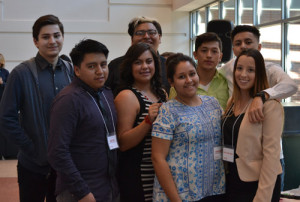At the start of the school year, leaders tackling some of society’s toughest problems shared their experiences with the students and then issued a challenge asking students to advance solutions. Challenges proposed to student groups by Kaiser Permanente, Denver Foundation, Denver Water, Mayor Hancock, Denver Police Department Chief White and others ranged from how to educate peers on water conservation, to improving behavioral health of schools by using art, to how to effectively build healthy relationships with the Denver Police Department. Each student group was able to choose what challenge they wanted to work to resolve and spent the next seven weeks building awareness, strategizing solutions, overcoming issues, and getting their schools and community involved. 
Want to see how these amazing students worked to create positive change in their schools? Watch a video recap of the event.
The Challenge: “Kaiser Permanente challenges you to improve the behavioral health of your school by using art to build community cohesion, grow emotionally strong and resilient young people, and increase a healthy awareness in learning.”
Schools Participating: Abraham Lincoln/RESPECT Academy, Bruce Randolph, Kunsmiller Creative Arts Academy (KCAA), Manual High School
The Problem: Behavioral problems distract other students from learning and require teachers to spend valuable instruction time on discipline and behavior management. One way to decrease behavioral issues in schools is through art. According to research conducted by the Childcare Education Institute, “art offers children an important outlet for emotional expression and the assurance that their feelings are valuable.” Artistic expressions can release some of the negative emotions that children carry with them or release through behavioral misconduct. Additionally, studies conducted by student groups show that students in art programs are 44% less likely to use drugs than their peers who don’t participate in art programs. Because of this, there is a need for art and art clubs to be more accessible so all students have the opportunity to freely express their emotions in a safe and supportive  environment.
environment.
Students’ Creative Solutions: Student groups created art workshops as a way for their peers to use art as a way to improve their behavioral health in a supportive, learning environment instead of outside of schools where substance abuse can occur. Students have increased efforts to educate their school’s teaching staff about the benefits of art and how it positively influences mental and physical behavior. Getting teachers involved has helped improve the student groups’ efforts. One group engaged the community in painting a mural, while another had a T-shirt decoration workshop. Another group, with administrative support, was able to secure a classroom for afterschool hours where students could go and work on art projects of their choice.
Measure of Impact: All student groups discussed increased participation in each workshop that they held. One group had an average of 15 students attending each art workshop. Word has spread around the school and more students are interested in attending. The more students in art programs afterschool, the less students there are that have time outside of school to engage in unsafe or detrimental behavior.
